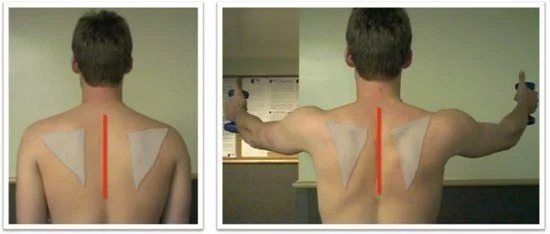The Neutral Shoulder Blade and Its Importance
The shoulder blade, or “scapula”, is a bone that helps attach your arm to your trunk and is located on the upper, lateral part of the body. Most people know about the “traps” and the “deltoids” but both these muscles actually attach to the scapula along with many other muscles of the neck, shoulder, and rotator cuff. The scapula is an integral part of any movement of the arm as it has to either stabilize or move with the arm.
Much like any other joint (where two bones meet together), there is a “neutral” or centered position of the scapula. This is important to be aware of because this is the “ideal” position of the joint and would be where the muscles that surround the joint are most balanced. This would also put the least amount of pressure/stress on passive structures like ligaments and cartilage in the area and be able to efficiently generate force. When it is not in its ideal or neutral position this leads to tightness and imbalances in the muscles surrounding it and could lead to pain in the neck and shoulder regions (more on joint positions in the post here)
The left picture shows neutral scapulae where the medial (inner) border is parallel with the spine.
So what is the neutral position of the scapula? In a static position (i.e. sitting or standing), the medial borders (the border closest to the spine) of the scapula should be about parallel with the spine and should also be away from the spine laterally. “Down and out” and “broad shoulders” are cues that are typically given to achieve this. The scapulae should also be right up against the ribs which means that they are not “winging” – you shouldn’t be able to grab the inner borders of your scapula with your hand (as shown in picture below).
The right shoulder blade is “winging” with the inner border coming outwards which is not a neutral position.
Contrary to what most people think of as “good posture”, squeezing the shoulder blades together in the back and puffing the chest out would not be considered a neutral position, as the scapulae would be retracted. On the other hand bringing the shoulders too far outward that it rounds the shoulders is not neutral either as the scapulae would be in a protracted position.
Squeezing the shoulder blades together is not considered neutral.
Training the neutral position starts with awareness – first at the trunk and then into the scapulae. The chest and pelvis need to be aligned first (as mentioned in the post here) and then the scapulae could also be positioned properly. This could be trained with static positions but also with dynamic movements of the arm and trunk.
With popular exercises like Rows or Pushups, when the arms are moving, the scapulae should be able to stay in its neutral position (“down and out”), up until the elbows go into extension past the body, which then the scapulae should retract (move closer to the spine). With other movements that require overhead activity (i.e. >90 degrees of shoulder abduction), the shoulder blade will be forced to move with the arm due to the normal “scapulohumeral rhythm”.
The quality of the positions and movement should be trained first – then add resistance. Quality first - then quantity. It is about training proper coordination and motor control of the muscles and joints together and not just strength of one muscle group.
Links:
Questions or comments? Contact us.




